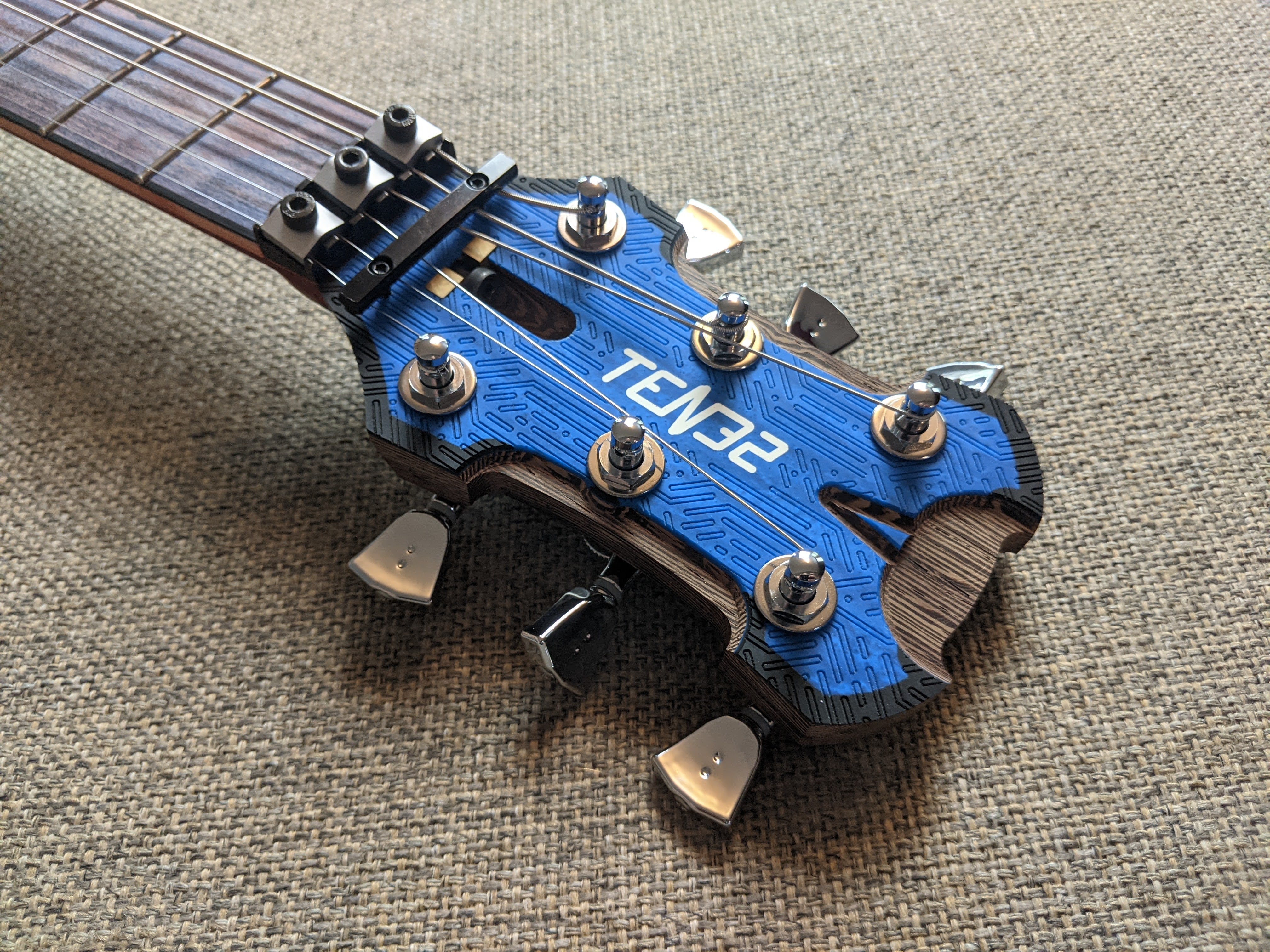Introducing TEN32 Guitars
This is the first of what I hope to be many blog posts about designing and building guitars and with any luck, building a successful business doing what I love most.
My name is Chaz, this is a photo of a photo of me. Same jacked up nose, different haircut.

"Whoa dude, aggressive."
I run this entire show out of a garage and a basement in Denver, CO. If you're wondering about the name TEN32 (which has nothing to do with Police codes), I signed up to be an exhibitor at NAMM 2011 with no brand name. I had nothing I liked. Turns out, the part number engraved into the front of the CNC I had only just bought was "1032" , which reads several different ways, so it was changed to "10-32", then eventually "TEN32". I rolled with it.
"Good story bro"
Thanks. I bought my first guitar in 1998, designed my first body somewhere around 2000, and attempted my first build around 2007. It didn't go well:

"Yikes."
Yeah...the good news is, 15 years later, things are looking a little better.


So what exactly are you looking at here? My hope is that you're seeing what appears to be a couple of pretty normal (but very sexy) electric guitars. There are plenty of things about the instrument that don't need changing. The foundations laid by the Leo Fenders and Lester Polfuses of the world are unshakeable, but that doesn't mean they don't need an a infusion of new thinking once in a while.
New thinking is my wheelhouse. There's a lot of functional horsepower under the hood of the guitars above, so lets get to the good stuff before I lose you.
Of the many unique features of Ten32 Guitars, one stands out.
The headstock bolts on....if you want it to.

"What!? Why!?"
I'm glad I'm pretending you asked, but first of all...
If the idea of a bolt-on headstock rubs you the wrong way, I also offer conventional necks.
But a conventional neck doesn't make for an interesting blog post, doesn't differentiate my product in a mature and saturated market, and it certainly doesn't move the instrument forward.
"So, why even mess with a bolt-on headstock?"
Here's the short version. Building necks with angled headstocks was a challenge when I was a noob, so the bolt-on headstock was intended to make building necks easier. The headstock and neck would both come out of flat lumber stock, and be either permanently or detachably connected to one another later. A familiar analogy is set necks and bolt on necks - one is permanent, one is detachable.
From here two things happened:
1) I realized a guitar with a detachable headstock, when disassembled, was small enough to fit in a carryon suitcase.
2) I began exploring how I could apply modularity to other parts of the instrument in useful ways.
Now we're entering dangerous territory...portable guitars! Yuck, right?
If you're like me, the images that come to mind when you hear the words "portable guitar" aren't exactly inspiring. Most attempts (in my humble opinion) are overthought, over-engineered, or make far too many sacrifices to remain classified as a "real" guitar - a "real" guitar being defined as one that a professional would feel comfortable relying on in a live performance or studio context.
Despite all the flailing (and I did a lot of flailing myself), The only thing that's really required to make a "real" guitar portable is shortening the neck. It's the only part that's too long/large to fit in a carryon suitcase. So how might one achieve this?
1) Eliminate the headstock entirely, or 2) make it detachable. Headless guitar necks are nothing new, but they do present a few more functional (and typically aesthetic) challenges than most guitarists are willing to take on, so I chose the latter.
"Bullsh*t. There's no good way to bolt a headstock to the end of a guitar neck."
Ten years ago, before I attempted it, I would've agreed with you 100%. 5 years ago, after trying several failed designs, I almost gave up. I could either make it work, but it would look terrible or vice versa - see for yourself:

Multiply the parts in this image by 5 and you'll get a sense of just how much failure I worked through. But...I REALLY wanted to travel with a legit guitar. I wanted to be inspired by the places I went, I wanted the influence of the people I met in those places to come across in my writing.
I wanted to lay down DI tracks from the top of a mountain in Maui.
So I persisted, and eventually I succeeded.
"That's a cute story. Does it actually work?"
It works spectacularly. So well in fact, that I dropped a large chunk of cash (OK, it was credit) on legal services to protect the idea.
If you're still with me, I'll get to the functional point of this post. It's simple really. A detachable headstock enables you to break the instrument down into three parts, all small enough to fit in a backpack, a carry-on suitcase, or....this:



You're looking at a full size, legit studio and stage ready guitar in a purpose-built case that fits under an airplane seat.
"You expect me to believe a guitar in a backpack can compete with the best instruments in the world? Not a chance."
I can't overstate it. There are no sacrifices.
The only extra work you'll be taking on compared to a normal neck is about 90 seconds to bolt everything up out of the case. From there, you string it up just like any other guitar, except you're confidently doing so in any number of places you'd never dare to take any other high end instrument. And obviously, when you're not travelling there's no need to disassemble it.
This may come off as aggressive or combative, but I can assure you, it's pure passion when I say...
I'm not playing, folks. I'll put my work up against anything ever built.
I may lose a battle or two along the way, but when the total utility value of my instruments is added up and weighed against the same value of any other guitar, I think that's a war I can win.
"Not buying it. You'll have to prove it."
No problem. Skip ahead a couple of posts if you must.
I did my time in the workforce. Layoffs, horrible bosses, doing everything right and never getting ahead, all that shit - but no more. I'm taking on risk and debt and guaranteed ridicule because life is too short to play by anyone else's rules. This is my chance to break out, and I genuinely hope I can inspire others to do the same.
I'm not here to be another greedy business owner, I'm not here to become an influencer or a YouTube celebrity. I'm here to be my real self, to be honest and transparent, to work with guitarists like you to maximize the instrument, the craft, and the music we all love because I'm truly afraid all that may cease to exist before my time is up.
So join me! Share your ideas - especially the crazy ones! Fight with me to keep our instrument relevant!
"Damn dude....settle down. We don't even know if it sounds good yet."
I will not settle down. Seriously - I don't know how. But I will give you the audio you're craving.


9 Comments -
Michael • -
TEN32 Guitars • -
Keith Dolven • -
Keith Dolven •
← 1 2
I’ve seen a few iterations trying to accomplish the same thing, but this goes several steps beyond what I’ve seen. This is niche, price seems fair for what it is trying to accomplish. I’m having a difficult time trying to figure out who might fit this niche, other than myself. I work in Aerospace and fly every 2 weeks, being able to bring a TSA compliant carry-on case would be nice, I’d just need my laptop, a cable and a scarlett solo and I’m good when I’m hanging out at a hotel. Personally, I’d like to see a headless version – to which I know there are some challenges behind that – and then use the saved space to have an external pocket (to put a phone charger/battery pack into) or have an open slot for either adding in a strap or room for an interface.
If it were headless to free up some room in the case for a strap and/or an interface, or had a chamber with external access for small things (think quick access while flying), then I would seriously consider this, I hate being away from my guitars for 2 weeks at a time, but I refuse to let the TSA “lose” another of my ESP’s, and carrying-on the guitar would solve that problem.
Thanks Keith, nice to hear from like minded players who understand my perspective! I already use extremely naturally stable lumber for necks and I think the addition of a bit more carbon fiber would completely eliminate the need for a truss rod. If I ever get the time I’d love to give it a try!
Baby sized steps which to most will appear as giant leaps, I have one thought regarding the neck. Personally and just from a design standpoint I truly dislike truss rods, and I believe that with modern material science that there’s little need for such. I’m not sure as to why I’ve not been aware of your efforts before today, but I’m very intrigued and impressed as well!
I could only smile as I read your blog posts. I’ve been working on my own ideas and designs and prototypes off and on since I was in high school (I’m 50), I especially enjoy the belief that there should be less inchworm like innovation and movement and more